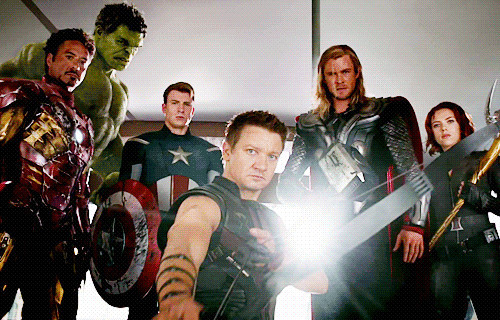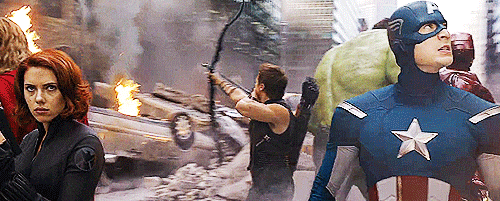
"THE AVENGERS" (2012) Review
Back in 2007, Marvel Studios set out to do something that DC Comics managed to achieve some forty-four years ago through a Saturday morning animated series. The studio initiated a series of movies based upon some of its company's popular comic book characters. This series first culminated into the 2012 hit movie, "THE AVENGERS".
The initial group of comic book heroes that became a team in "THE AVENGERS", turned out to be the following - Iron Man, Captain America, Thor, the Hulk, the Black Widow and Hawkeye. The first four starred in their own movies in what has become known as "Phase One" of the Marvel Cinematic Universe (MCU). And the last two characters, the Black Widow and Hawkeye, appeared as supporting characters in 2010's "IRON MAN 2" and 2011's "THOR" respectively. Each movie, starting with 2008's "IRON MAN", hinted at the formation of Marvel Comics' team of superheroes.
Written by Zak Penn and Joss Whedon and directed by the latter, "THE AVENGERS" begins with Loki, the villain from "THOR" and the latter's adopted brother, making a deal with the leader of the Chitauri aliens called the Other to lead an army on Earth, in order to subjigate the human race. In order to do this, Loki needs to retrieve the Tesseract, a powerful energy source originally found on Earth in "CAPTAIN AMERICA: THE FIRST AVENGER". The Tesseract opens a doorway that allows Loki to arrive a top secret S.H.I.E.L.D., use his scepter to enslave a few agents, Dr. Eric Selvig and Clint Barton aka Hawkeye and take the Tesseract.
In response to Loki's attack, S.H.I.E.L.D. Director Nick Fury reactivates the Avengers Initiative. He, along with agents Phil Coulson and Natasha Romanoff aka the Black Widow; recruits Steve Rogers aka Captain America, Tony Stark aka Iron Man and Dr. Bruce Banner aka the Hulk to form a team and stop Loki's plans and recover the Tesseract. Both Captain America and Iron Man manage to capture Loki in Germany. But during a flight back to the States, Thorarrives and frees Loki, hoping to convince him to abandon his plan and return to Asgard. Instead, a confrontation ensues between the three heroes before Thor agrees to accompany them all back to the Helicarrier, S.H.I.E.L.D.'s flying aircraft carrier. Despite Loki being a captive, the Avengers still need to find the missing Tesseract. Even worse, Loki does not remain a captive very long.
Nearly five years had passed since "THE AVENGERS" first hit the movie screens. And during its time in the movie theaters, it became one of the highest-grossing film of all time. Most fans and critics of comic hero movies tend to view any film with more than one villain as a box office or critical disaster. And yet . . . many of these same critics and fans seemed to have no problem with a movie featuring six comic book heroes. I find that rather . . . odd and contradictory, but there is no explaining humanity's chaotic nature. I have never had a problem with a comic book movie featuring more than one villain or hero, as long as that movie was well written. And I cannot deny that Whedon and Zak Penn wrote a first-rate movie.
First of all, Marvel Studios had made the wise decision to map out the movie's plot with four to five other movies. This enabled them to set up most of the characters before shooting "THE AVENGERS". Natasha Romanoff had received a small introduction in "IRON MAN 2". And Clint Barton was allowed nothing more than a cameo appearance in "THOR". This meant that these two were the only ones left to be properly introduced in this film, along with their previous relationship as S.H.I.E.L.D. agents. Even the Tesseract, the energy source that Loki will use to allow Chitauri warriors to invade Manhattan in the movie's last act, had originally been introduced in "CAPTAIN AMERICA" and hinted briefly in "IRON MAN 2" and in the Easter Egg scene for "THOR". I wish I knew who had the idea to set up the story and characters for "THE AVENGERS" in previous movies. I would congratulate him or her for convincing Marvel to pursue this course of storytelling. For it paid off very well.
Second, I was impressed at how the main cast members - especially those portraying members of the Avengers - managed to click so well and create a viable screen team. Whedon and Penn's script did not make it easy for them. Only the Black Widow and Hawkeye initially felt comfortably working together and even their relationship was disrupted by Loki's temporary enslavement of Hawkeye's mind. I could point out one or two particular performances by the cast. But if I must be honest, practically all of them stepped up to bat and performed beautifully. Okay, I must admit there were a few dramatic scenes that really impressed me.
I enjoyed the quarrel between Tony Stark and Steve Rogers, thanks to Robert Downey Jr. and Chris Evans, who did a great job in developing the characters from initial hostility and wariness to trust and teamwork. I also enjoyed Chris Hemsworth and Tom Hiddleston, who continued their outstanding work and screen chemistry as the two Asgardian siblings, in a scene in which Thor tries to convince Loki that he and their family still loved the latter, despite his actions in "THOR". Scarlett Johansson managed to appear in three scenes that impressed me. One featured a contest of will and intellect between her Black Widow and Hiddleston's Loki. Another featured both her and Mark Ruffalo, as she manages to convince Bruce Banner to help S.H.I.E.L.D. to track down the Tesseract. But my favorite scene featured a heart-to-heart conversation between Natasha and her old partner, Clint Barton, as they discussed her past and his mind enslavement by Loki. Samuel L. Jackson did an excellent job as the intimidating, yet manipulative director of S.H.I.E.L.D., Nick Fury. He also seemed surprisingly spry for a man in his mid-60s, as his character dodged several near death experiences. Clark Gregg was entertaining as ever as one of S.H.I.E.L.D.'s top agents, Phil Coulson. It was nice to see Stellan Skarsgård repeat his role as Dr. Eric Selvig. Although his role was not particularly big, Selvig had a major impact on the plot. And Skarsgård managed to give his usual, top-notch performance. Cobie Smulders managed to hold herself well as one of Fury's assistants, Maria Hill. It is a pity that Whedon was unable to showcase Alexis Denisof a little more as leader of the Chitauri aliens. I suspect that being cloaked and hidden in the small number of scenes probably did not help much, in the end.
I remembered that Mark Ruffalo's portrayal of Bruce Banner/the Hulk has received rave reviews from the critics and the fans. Many critics had also suggested that his portrayal of the character was superior to both Eric Bana's performance in 2003 and Edward Norton's 2008 portrayal. I say bullshit to that. I suspect that the critics had spouted this crap, because Ruffalo got to portray the Hulk in a movie that proved tobe a box office and critical hit. Ruffalo did a great job in portraying Bruce at this later stage of his existence as the Hulk. However, I also feel there was nothing exceptional about his performance that made his Hulk superior to Bana and Norton's. This whole notion of Ruffalo giving a better performance than the other two actors strikes me as nothing but a lot of fanboy horseshit.
One cannot talk about "THE AVENGERS" without discussing the film's visual effects. What can I say? They were outstanding. Well . . . somewhat outstanding. Seamus McGarvey's photography struck me as very effective in giving the movie an epic feel. And his work was vastly assisted by the visual effects team led by Jake Morrison. For a movie set either in New York City, or over the Atlantic Ocean, aboard a flying aircraft carrier, I was very surprised to learn that a great deal of the movie was shot in both Albuquerque, New Mexico and Cleveland, Ohio. Surprisingly, the film crew only spent two days shooting in Manhattan.
I do have a few complaints about "THE AVENGERS". One, although I was impressed by Whedon's direction and McGarvey's photography, I cannot say the same about the work they did for the Black Widow/Hawkeye fight scene aboard the Helicarrier. To be honest, I found it slightly murky and confusing. Jeffrey Ford and Lisa Lassek's editing did not help. Their work revived bad memories of Paul Greengrass' quick-cut editing at its worst. Honestly? Jon Favreau did a better job of shooting her fight scenes in "IRON MAN 2". I also realized that Whedon had been talking out of his ass, when he claimed that a good deal of the movie would be shown from Steve Rogers' point-of-view. One, I never thought that Whedon had a firm handle on the Steve Rogers' character. Whedon's Steve Rogers aka Captain America seems willing to question authority figures - only in extreme circumstances. This is not the Steve Rogers who is more inclined to follow his own path than blindly follow orders. Even worse, the film never really hinted any troubles Steve may have experienced dealing with the early 21st century. And then we come to the Dr. Bruce Banner aka the Hulk character. Could someone explain why the Hulk turned out to be more powerful than a pair of Norse gods - namely Thor and Loki? How in the hell did that come about? This certainly was not the case over fifty years ago, when Thor beat the pants of both the Hulk and the Sub-Mariner in the Marvel issue, Avengers #3 (Jan. 1964). Could someone please explain this phenomenon?
I have another minor problem with the movie. In the past five years, fans of the MCU movies have been aware that the Titan supervillain, Thanos, has been collecting all of the Infinity stones, including the Tesseract featured in this film. And yet … Thanos handed over one of the stones - the Mind Stone set in a scepter - to Loki for the latter’s use during the Chitauri’s invasion of Earth. Why would he do that? Thanos is going through a great deal of trouble to get his hands on the Infinity stones. Why would he hand over the only stone - even temporarily - he had in his possession? That makes no sense to me. If I had been Thanos, I would have kept that stone close to me, no matter what.
"THE AVENGERS" may not be perfect. But it is still obviously one of the best comic book movies I have seen, hands down. And it turned out to be one of the best movies of 2012. It deserved all of the accolades it had received. And for the first time in his career, Joss Whedon seemed to have directed a movie that matched his work with his "BUFFY THE VAMPIRE SLAYER" and "ANGEL" television series.







